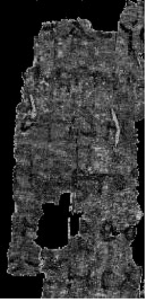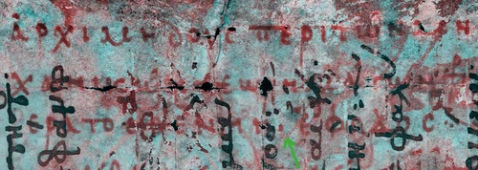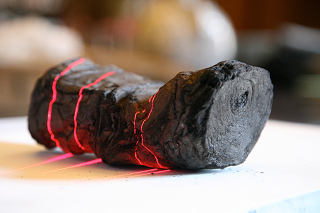Multispectral Imaging
By Jared Matzke
If you’re here, you probably already know: reading papyri is hard. Indeed, sometimes the letters are so faded and the fragment so pitted and creased that it’s not just hard, it’s impossible. How cruel, to recover a bookroll that survived the heat and flames of a volcanic eruption, centuries of underground entombment, followed by the callous handling of traders and treasure hunters, only to see it remain unread, resting silently in a museum. Such is the fate of many of the Herculaneum papyri, and similar fates have befallen scores of others, miraculously saved from time’s destruction, yet unreadable and tantalizing. We must accept that there is only so much our eyes can glean from a text charred black by flames or rubbed clean by an indifferent scribe. Lately though, papyrologists have been using more than just their eyes to read these texts.
Most of us are well aware that there is light beyond the ordinary visible range. There is the UV light that will give you a sunburn, the gamma rays that might give you cancer, the infrared light that lets police see through walls with thermal cameras. Indeed, there is a continuous spectrum of light, only a sliver of which is visible to us. It is another familiar notion that some substances absorb light while others allow it to pass through. But a perhaps not as familiarobservation—yet very well understood—, is that each material has a unique interaction with light, and it absorbs only some portions of the spectrum and transmits others. Glass, though transparent to visible light, is opaque to infrared, so that a person standing behind an ordinary window pane would be invisible to a thermal camera, although obviously visible to the ordinary human eye. Because every type of molecule has a unique absorption spectrum (like a fingerprint), materials can be identified on the basis of what sorts of light they absorb or transmit. Ink and papyrus, for instance, have different characteristic absorption spectra. Good spatial resolution can be achieved as well, such that letters can be clearly distinguished from the surrounding papyri when a fragment is imaged using a broad spectrum of light. This technique is know to papyrologists as multispectral imaging, and is now used extensively in papyrological research. See the additional clarity brought to this muddled papyrus by multispectral imaging techniques.
(MSI images are courtesy of the Imaging Papyri Project, University of Oxford)
But perhaps the nice improvement in contrast seen here doesn’t quite strike you as an earth shattering triumph of modern science. Fortunately, multispectral analysis can do much more. A number of important texts have come down to us as palimpsests; that is, manuscripts on which the original writing has been thoroughly erased in order that the material be repurposed for another text. In the visible portion of the spectrum, the original text is completely gone. In the infrared and ultraviolet however, traces remain. What’s more, because the original and subsequent texts are in different inks, the different layers of text can be distinguished based on the differences in their absorption spectra. Perhaps the best example of this application of multispectral techniques is the Archimedes Palimpsest
(Copyright: the Owner of the Archimedes Palimpsest. Licensed for use under Creative Commons Attribution 3.0 Unported Access Rights)
Impressive, but what about those unopened bookrolls? What are we to do when our treasured fragments of ancient lives haven’t been delivered to us in crisp, flattened pages, or folded neatly in codices? Lately techniques are being advanced that utilize x-rays to obtain not just a two-dimensional map of, say, a sheet of papyrus, but a three-dimensional, textured surface of complicated objects like bookrolls. Ink, with its dense conglomeration of organic molecules, has a different susceptibility to x-ray radiation than papyrus, which is much less dense and mostly comprised of air. This difference allows for image contrast. More interestingly though, the use of computed tomography—which utilizes a composition of many x-ray images to form a succession of two-dimensional slices along a third axis, and is familiar to many of us as the medical CT scan—allows any particular pixel to be associated with a point in three-dimensional space. The entire volume can then be segmented layer by layer, ultimately resulting in a reconstruction of the text’s contents in a readable, planar format.
(Photo: Steve Bailey for the EDUCU project. Brent Seales, a University of Kentucky computer science professor, and his research team attempting to read carbonized bookrolls using an X-ray CT scan.)
The techniques presented above are only a selection of those available to papyrologists, and the development of novel methods for imaging papyri is an active area of research. The emerging techniques range from the exotic world of particle physics to the simple principles of optics. As these scientific techniques become increasingly accessible, papyrologists are beginning to read opaque texts without ever opening a bookroll.
Bibliography
Easton, R., et al., “Spectral Image Processing and Analysis of the Archimedes Palimpsest”; 19th European Signal Processing Conference; Barcelona, Spain; 2011.
Lin, Yun & W. Brent Seales, “Opaque Document Imaging: Building Images of Inaccessible Texts”; Proceedings of the Tenth IEEE International Conference on Computer Vision; 2005.
Ware, Gene A., et al., “Multispectral Document Enhancement: Ancient Carbonized Scrolls”; IEEE; 2000.




